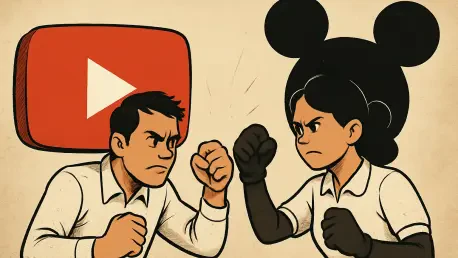In a rapidly evolving streaming landscape, a significant conflict has emerged between Google’s YouTube TV and Disney, raising concerns over a potential blackout of popular content for millions of subscribers across the nation. This dispute, centered on distribution agreements and pricing terms, could see Disney-owned channels, including heavyweights like ESPN and ABC, disappear from the platform if a resolution isn’t reached by the looming deadline of 11:59 PM ET on October 30. Such a disruption would impact access to live sports, news, and entertainment programming cherished by viewers. The tension highlights a broader struggle within the industry, where content providers and streaming services grapple with balancing profitability and affordability. As negotiations stall, subscribers are left in limbo, facing the uncertainty of losing marquee content. This clash not only affects immediate viewing options but also underscores deeper systemic challenges in how digital media is distributed and valued in today’s competitive market.
Unpacking the Core Disagreement
The heart of the dispute between YouTube TV and Disney lies in a fundamental disagreement over the financial terms of their distribution deal, with each side staunchly defending its position. Disney contends that its substantial investment in high-quality content, spanning sports, entertainment, and news, justifies a pricing structure that reflects this value. Public statements from Disney have emphasized the risk to subscribers of losing access to critical programming, framing the company as a protector of content worth. Meanwhile, YouTube TV argues that the proposed terms are economically unfeasible, potentially forcing a hike in subscription fees that could alienate its reported 10 million users. The platform has positioned itself as a defender of consumer choice, suggesting that Disney’s demands unfairly favor its own competing services like Hulu + Live TV. This clash of perspectives reveals a high-stakes negotiation where both parties are striving to protect their business models while under intense public scrutiny from affected viewers.
Beyond the immediate financial discord, the dispute also reflects differing approaches to customer communication and crisis management during such conflicts. Disney has taken a proactive stance, issuing warnings through social media and directly on YouTube TV’s interface to alert subscribers about the looming blackout risk. This move aims to pressure the streaming service by mobilizing public concern. In contrast, YouTube TV has adopted a more reassuring tone, promising a $20 credit to subscribers if Disney content remains unavailable for an extended period. This gesture seeks to mitigate potential backlash while maintaining the narrative of negotiating in good faith. The contrasting strategies highlight how each company perceives its responsibility to subscribers, with Disney focusing on transparency about risks and YouTube TV emphasizing damage control. As the deadline approaches, these differing tactics underscore the complexity of maintaining customer trust amidst contentious business negotiations.
Industry-Wide Implications
The standoff between YouTube TV and Disney is not merely a bilateral issue but a microcosm of broader challenges facing the streaming and media industry as a whole. Content distribution disputes have become increasingly common as streaming platforms grow in influence, often clashing with traditional content providers over carriage agreements. This particular conflict marks the fourth such disagreement for YouTube TV this year alone, following earlier tensions with other major providers like Paramount and Fox. Although those prior disputes were eventually resolved, the recurring nature of these conflicts points to a systemic struggle in achieving equitable pricing models that satisfy both distributors and creators. The outcome of this current negotiation could set a precedent for future deals, influencing how streaming services balance content costs with subscriber affordability in an era of fierce competition and fragmented viewing options.
Moreover, the potential blackout of Disney content serves as a stark reminder of the direct impact such disputes can have on consumers who rely on streaming services for their entertainment and information needs. Subscribers risk losing access to live sports events like NFL and NBA games, alongside staple programming from ABC, which could disrupt viewing habits significantly. This scenario raises questions about the stability of streaming as a primary media consumption method when access to popular content hangs in the balance of corporate negotiations. The tension also highlights the growing power dynamics between content giants and streaming platforms, where each seeks leverage—Disney through its valuable portfolio and YouTube TV through its expansive user base. As the industry evolves, these disputes may push regulators and stakeholders to explore frameworks that prioritize consumer access while addressing the economic realities faced by both sides in the digital content ecosystem.
Navigating the Path Forward
Reflecting on the developments, the negotiations between YouTube TV and Disney reached a critical juncture as the October 30 deadline passed without a definitive resolution, leaving subscribers in a state of uncertainty. The potential loss of Disney-owned channels became a reality for some, disrupting access to beloved programming and live events. Disney maintained its stance on securing fair compensation for its content, while YouTube TV held firm on protecting subscribers from price increases, even offering temporary credits as a buffer. Both companies faced scrutiny from users caught in the crossfire of this corporate standoff, with many expressing frustration over the instability of streaming access. The situation underscored the fragility of content agreements in the digital age, where business interests often collide with consumer expectations.
Looking ahead, the resolution of this conflict, whether through compromise or continued blackout, offers valuable lessons for the streaming industry as it navigates uncharted territory. Stakeholders are encouraged to consider more sustainable models for content distribution that could prevent such disruptions in the future. Collaborative approaches, perhaps involving third-party mediation or standardized pricing frameworks, emerge as potential solutions to balance the needs of content creators and distributors. For subscribers, exploring alternative viewing options or advocating for greater transparency in negotiations becomes a practical step to mitigate the impact of similar disputes. The outcome of this particular disagreement serves as a catalyst for broader discussions on how to ensure reliable access to digital media, shaping policies and practices that could redefine the relationship between streaming platforms and content providers for years to come.









